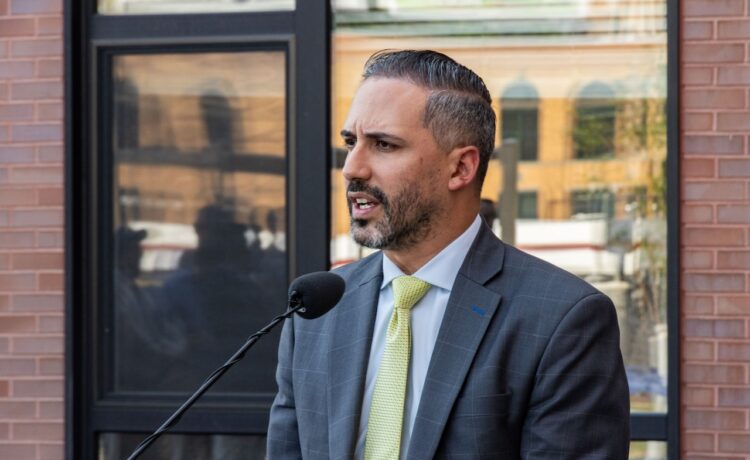Worcester City Manager Eric D. Batista is proposing an operational budget for Fiscal Year 26 that is just shy of $1 billion.
The budget proposed by Batista is $947,928,261, a 3.3% increase in revenues and expenses from the present fiscal year, according to the budget.
In a briefing with reporters on Tuesday, Batista outlined the budget and its components.
Included in the budget are funding increases to the fire department for gear that does not contain toxic chemicals and a plan to separate the Parks department from the Department of Public Works, among other proposals.
“We’re really focused on equipment, maintenance of our properties, and also our people,” Batista said. “And if we can take care of the foundation, then, over time, things will start to work out.”
Additionally, Batista is also seeking authorization for $158,938,412 in borrowing for several key projects, including the construction of a new South Division Fire Station and the feasibility study for a new Burncoat High School and Middle School.
The budget will be put before the Worcester City Council at their meeting on Tuesday night. The city council agenda reads that there will be a recommendation to refer the budget to the finance committee.
A hearing on the budget will take place on May 13 at the city council’s next meeting, according to a packet Batista handed out to reporters on Tuesday.
Where the money is being spent
The expenses for Fiscal 26 are separated into five categories: Education, Public Safety, Infrastructure, Fixed Costs and other remaining city services.
Of the five categories, education makes up $574.4 million, or 60.8% of the budget, according to Batista. Compared to Fiscal 25, the education budget increased by 7.7%
Public Safety, which includes the Worcester Police and Fire Departments, inspectional services, and emergency communications, comprises $122.7 million of the total $947.9 million budget. This number is a $9 million or 8% increase in proposed expenses according to the budget.
Batista explained that the increase in public safety was largely due to bargaining agreements.
As for the other categories, $163 million will be spent on fixed costs, $29 million will be spent on infrastructure and $57 million will be spent on other city services, the budget reads.
The city’s contingency budget is estimated to be $5 million.
Funding for non-PFAS equipment
As part of the budget, there will be funding for firefighter equipment that does not contain a toxic chemical known as PFAS, according to Batista.
PFAS, or per- and poly-fluoroalkyl substances, are artificial chemicals that have been linked to a variety of health concerns in humans, such as fertility issues, low birth weights, and an increased risk of cancer, according to the Centers for Disease Control and Prevention.
In 2024, Gov. Maura Healey signed a bill that requires manufacturers to provide written notice to local governments, state agencies, and other buyers if their firefighting protective equipment has PFAS chemicals, according to State House News Service.
This year, the city will be providing PFAS-free gear to its firefighters for the very first time, Batista said.
The funding is part of the firefighters’ budget, which has been increased by $5.2 million to accommodate increased overtime, building maintenance and repair, as well as bargaining agreements and salary changes.
Plans to split the parks department
During Tuesday’s meeting, Batista went into more detail about his plan to separate the Parks Department and the Department of Public Works (DPW). The two departments were combined under a previous Worcester City Manager, Michael O’Brien, according to Batista. Even though they are part of the same department, the two act as independent bodies, Batista explained.
By breaking them apart, Batista seeks to streamline reporting and accountability from the Parks Department to him.
“It gives us better management,” Batista explained.
In his letter to the councilors, Batista said that the financial shift would be minimal. Additionally, Batista wrote to the councilors that the budget calls for an increase in funding for park cleanups and aquatic maintenance.
Batista said the separation of the two departments would occur on July 1.
Batista aware of potential headwinds
Batista acknowledged that the budget proposal may face challenges, with state local aid being the largest one. Aid from the state is dependent on the passing of the state budget. So far, only the Massachusetts House of Representatives has passed its state budget.
There is also concern about whether there will be any cuts from the federal government, namely at the Department of Housing and Urban Development (HUD)
While there are no cuts set in stone, Batista said that 10 staff members in the city’s economic development department are federally funded through programs by HUD.
“Those are the things that we’re monitoring in terms of what the impact would be,” Batista said. “We won’t know from the federal government whether we receive status quo budget or decreases or increases to HUD for another week or two.”





